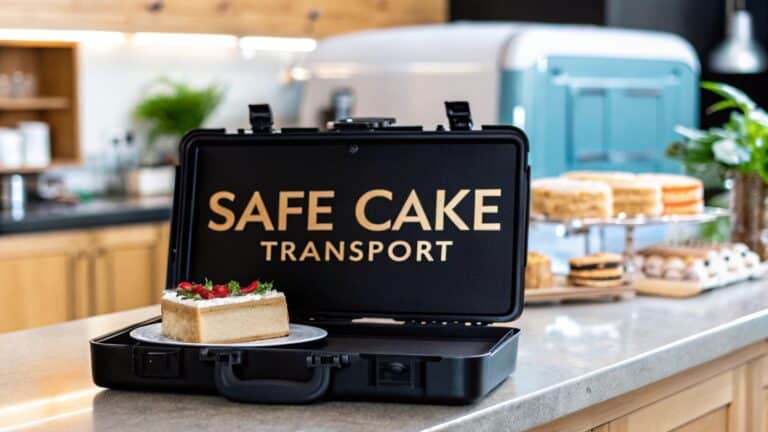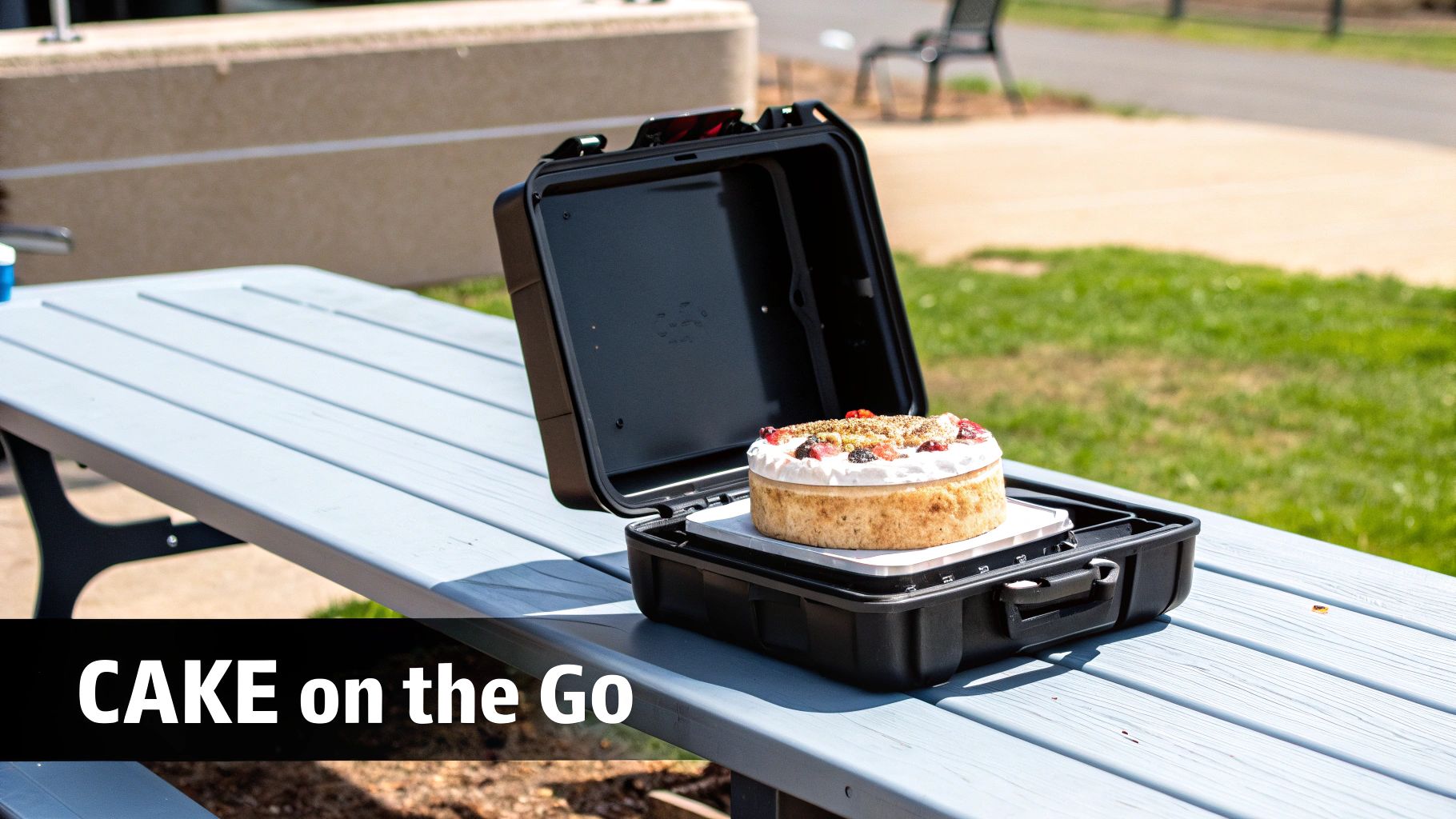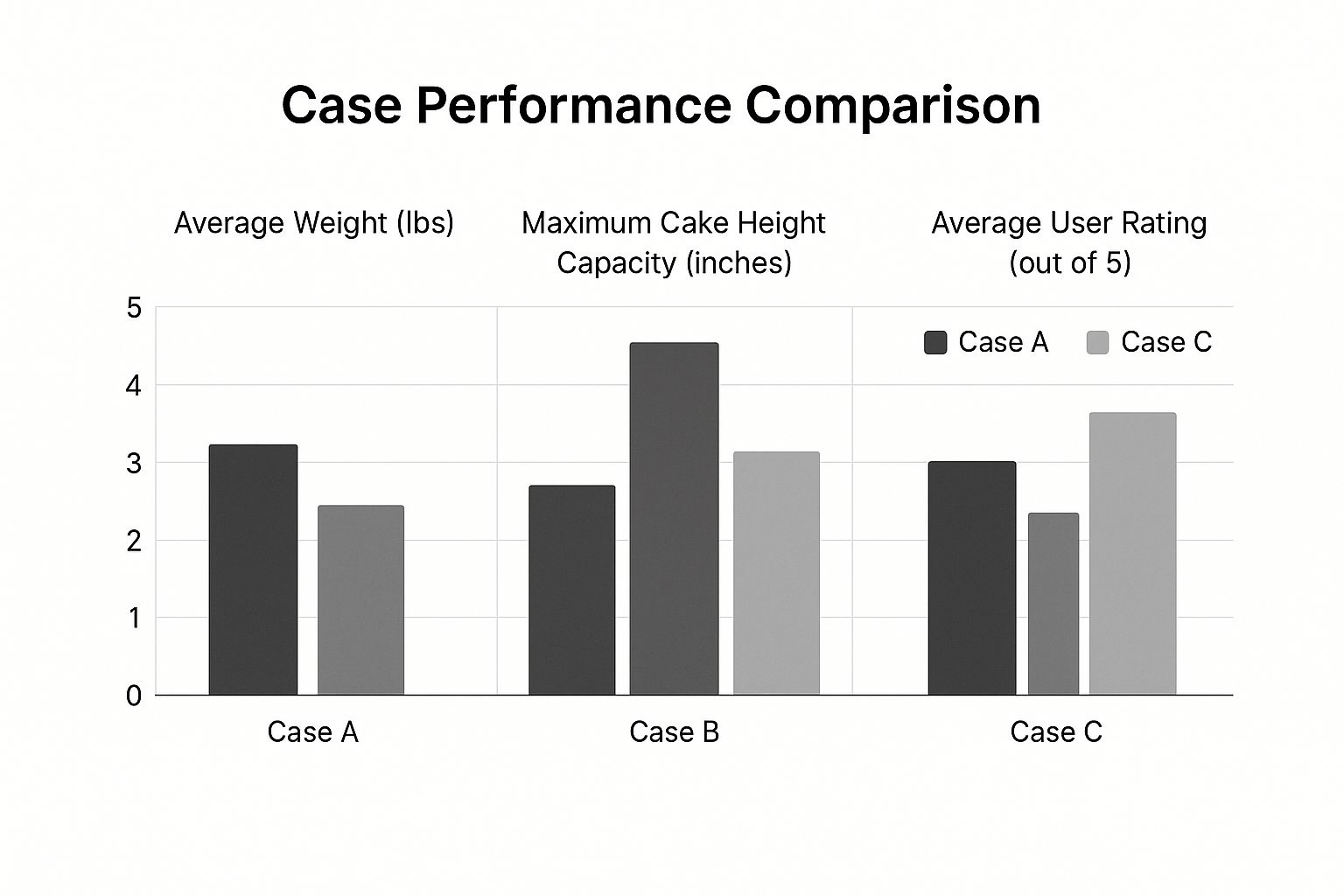Why Your Cake Deserves a Superior Carrying Case
Imagine presenting a stunning cake, a true masterpiece of flavor and design. Now, picture that same cake arriving at its destination lopsided, smudged, or worse. A high-quality cake carrying case protects your hard work and reputation. It’s an investment worth making.
Presentation Matters: The Psychology of a Perfect Arrival
First impressions matter. A pristine cake, presented in a professional carrying case, elevates the entire experience. This visual appeal speaks volumes about your attention to detail and commitment to quality. It creates a memorable moment for the recipient. A superior carrying case signals that the cake inside is something special. This enhances the perceived value and reinforces your brand.
Beyond Melting: Temperature and Texture Control
Temperature control is critical, not just for preventing melting, but also for preserving texture and flavor. A good carrying case is a protective barrier against temperature fluctuations. It ensures your cake arrives in perfect condition. A mousse cake, for instance, needs a stable, cool environment. A buttercream cake is more resilient but still benefits from protection.
The Unboxing Experience: A Modern Ritual
The “unboxing” has become a key part of gifting. A well-designed cake carrying case adds elegance and anticipation to this experience. The global cake box market is growing rapidly, projected to reach USD 4.5 billion by 2032. This growth reflects increasing consumer appreciation for premium packaging and specialized carrying solutions.
Professional Bakers: Brand Extension and Client Confidence
Professional bakers know the value of a superior carrying case. They use it as a brand extension, showcasing professionalism and a commitment to excellence. A branded case builds client trust and reinforces a reputation for quality. Features like secure locks and non-slip bases are crucial for preventing damage in transit.
Investing in a quality cake carrying case is investing in your success. It’s not just about transporting a cake. It’s about preserving your creation, enhancing the recipient’s experience, and building your brand. This attention to detail elevates your baking operation and sets you apart.
Finding Your Perfect Match: Cake Carrying Case Types
Choosing the right cake carrying case is crucial for any baker, whether you’re a seasoned professional or a passionate home baker. Just as different cakes require specific ingredients and techniques, different transportation needs call for specific case features. Selecting the right case ensures your masterpiece arrives in pristine condition, ready to wow.
Case Types: From Simple to Sophisticated
Cake carrying cases run the gamut from simple, budget-friendly options to sophisticated, temperature-controlled models. Cardboard cake boxes are perfect for quick trips and smaller cakes. They’re easily accessible and cost-effective for single use. Plastic cake carriers offer more durability and often include handy features like snap-on lids and handles. For delicate creations and longer journeys, insulated cake carriers provide temperature stability and protection against bumps in the road. Finally, professional aluminum cake carrying cases offer the ultimate protection, with reinforced corners, secure latches, and sometimes even climate control.
To help break it down, here’s a quick look at the benefits of each:
- Cardboard: Affordable, lightweight, and best for short distances.
- Plastic: Durable, reusable, and ideal for everyday transport.
- Insulated: Temperature-controlled and suitable for sensitive cakes and longer travel.
- Aluminum: Maximum protection, preferred for professional transport and tiered cakes.
This leads us to the next important step: matching the case type to your specific needs.
Matching the Case to Your Needs
The ideal cake carrying case depends on several factors. These include the cake’s size and fragility, the distance and method of transportation, and the environmental conditions. A simple sheet cake traveling a short distance in mild weather might only need a cardboard box. However, a towering wedding cake transported across town on a hot day requires a sturdy, insulated carrier. Understanding case performance is key.
To help illustrate the differences between cases, the infographic below compares three different cake carrying case models based on their average weight, maximum cake height capacity, and average user rating.
Case Model C has the highest user rating and impressive cake height capacity, even though it’s the heaviest. This suggests a focus on robust construction and user-friendliness, which likely explains the extra weight. Model A, on the other hand, is the lightest but has a lower height capacity and user satisfaction, pointing to a more basic, budget-friendly design.
Considering these factors helps determine which case offers the best balance of features for your individual needs. Market trends also offer valuable insights into cake transportation. The cake boxes market, crucial for safe transport, is expected to grow from USD 458.9 million in 2025 to USD 712.6 million by 2035. Growth in the United States is projected at a CAGR of 3.0% through 2035, driven by increasing demand for custom and premium options for special occasions.
To further compare different cake carrying case types, let’s look at the following table. It highlights the key features and best uses for each type, helping you make the most informed decision.
Cake Carrying Case Comparison
| Type | Portability | Durability | Temperature Control | Price Range | Best For |
|---|---|---|---|---|---|
| Cardboard | High | Low | None | Low | Short distances, single use |
| Plastic | Medium | Medium | None | Medium | Everyday transport, reusable |
| Insulated | Medium | Medium | Moderate | Medium-High | Sensitive cakes, longer travel |
| Aluminum | Low | High | High | High | Professional transport, tiered cakes |
As you can see, each type of cake carrying case offers distinct advantages and disadvantages. Consider your budget, the type of cake you’re transporting, and the travel distance when selecting the best option.
Beyond the Basics: Premium Features
Beyond the basic case types, several premium features can enhance your cake-carrying experience. Non-slip bases prevent sliding during transport, while secure locking mechanisms keep the lid firmly in place. Adjustable shelves or tiers accommodate cakes of various heights, maximizing space and minimizing movement. Some cases even offer built-in cooling packs or ventilation systems to maintain optimal temperature and humidity levels, which is particularly important for delicate frostings and fillings. Evaluating these features along with your transportation needs ensures a safe and successful delivery every time.
Must-Have Features That Prevent Cake Disasters
Transporting a cake can feel like a high-stakes mission. One wrong move and hours of work could be ruined. But with the right cake carrying case, you can transform this precarious journey into a smooth, confident delivery. More than just getting a cake from point A to point B, a good case preserves the cake’s quality and its beautiful presentation. So, what features make a cake carrying case truly great?
Secure Locking Mechanisms: Keeping Your Cake Intact
A secure locking mechanism is a non-negotiable feature for any dependable cake carrying case. Flimsy latches or a loose-fitting lid can spell disaster, especially on bumpy roads. A strong locking system, like sturdy side clips or a tightly sealed lid, will keep your cake from shifting or sliding during transport. This is particularly important for tiered cakes or those with delicate decorations.
Ventilation and Humidity Control: Preserving Freshness
Believe it or not, ventilation is key to keeping your cake fresh. While an airtight seal might seem like the best way to protect your cake, it can actually trap moisture and lead to a soggy mess. Strategically placed vents allow air to circulate, preventing the cake from drying out while minimizing humidity. Some premium cases even offer humidity control features to further protect delicate frostings and fillings.
Handle Placement and Design: Balanced and Comfortable Carrying
Handle placement and design significantly impact how easy and safe it is to carry your cake. Handles that are too close together can make the case awkward and unbalanced, increasing the risk of dropping it. Look for handles that are evenly spaced and ergonomically designed for a comfortable grip. This will help you maintain a secure hold, even when navigating stairs or uneven terrain.
Shock Absorption and Non-Slip Surfaces: Minimizing Movement
Protecting your cake from vibrations and sudden stops is crucial. Shock-absorbing feet or a padded base significantly reduce the impact of bumps and jolts during transport. These features cushion the cake and prevent it from getting jostled around. Non-slip surfaces on the base and interior of the case also prevent sliding. This combination of features ensures your cake arrives looking as pristine as when it left your kitchen.
Adjustable Tiers and Dividers: Accommodating Different Cake Sizes
Adjustable tiers and dividers make a cake carrying case incredibly versatile. They allow you to customize the interior space to fit cakes of all shapes and sizes. Adjustable tiers can accommodate taller cakes or tiered creations, while dividers create separate compartments for smaller individual cakes or pastries. This adaptability means one case can handle a variety of baking projects.
The evolution of bakery packaging has impacted the cake carrying case market, reflecting changing consumer preferences. The global bakery cases market is projected to grow from USD 10.1 billion in 2025 to USD 16.5 billion by 2035, with a CAGR of 5.8%. This growth highlights the increasing demand for hygienic and visually appealing cases that maintain freshness. Investing in a cake carrying case with these key features protects your creations and ensures a successful, stress-free delivery.
Material Science: What Your Cake Carrying Case Is Made Of
The materials used in your cake carrying case play a crucial role in ensuring your cake arrives in perfect condition. They influence everything from maintaining a stable temperature during transport to preserving the cake’s flavor. Selecting the appropriate material can truly make the difference between a flawless presentation and a cake catastrophe.
Food-Grade Plastics: A Closer Look
Many cake carrying cases utilize food-grade plastics. However, it’s important to understand that not all plastics are equal. Some excel at preventing odor transfer, a critical factor in preserving your cake’s delicate flavor profile, while others prioritize structural integrity, ensuring the case can withstand the journey. High-density polyethylene (HDPE), known for its durability and resistance to cracking, is a popular choice. Polypropylene (PP) is another frequently used plastic, valued for its heat resistance and ability to handle temperature fluctuations.
Sustainable Materials: Finding the Right Balance
For bakers concerned about environmental impact, bioplastics and recycled plastics offer appealing sustainable alternatives. However, performance must be carefully considered. Some eco-friendly materials may not hold up under the weight of a heavier cake, while others offer surprising strength and insulation. Thorough evaluation is key to finding a sustainable material that provides adequate protection for your creations. Just like maintaining your cake carrying case, ensuring other important business tools are in top shape is essential.
Metal Cases: The Advantages of Aluminum
Aluminum cake carrying cases are a favorite among professional bakers. Their superior durability and temperature control make them well-suited for transporting delicate tiered cakes, especially over long distances. Aluminum is also lightweight and corrosion-resistant, a combination of features that makes it a worthwhile investment for those frequently transporting cakes.
Evaluating Materials: A Professional Approach
Professional bakeries carefully consider several key factors when selecting materials for their cake carrying cases:
- Cleaning Efficiency: How easy is it to sanitize the case and avoid cross-contamination?
- Temperature Performance: Does the material effectively insulate against both heat and cold?
- Longevity: Will the case withstand regular use and provide long-term value?
The Science Behind Cake Freshness
The interaction between the cake and the carrying case material can significantly impact both freshness and presentation. Certain materials might absorb moisture from the cake, leading to a dry, undesirable texture, while others could release odors that taint the flavor. A cardboard cake box, for instance, can absorb moisture from a humid environment and soften, potentially damaging the cake’s structure.
A high-quality plastic case, on the other hand, creates a barrier against humidity, preserving the cake’s texture and preventing the frosting from sticking to the lid. Understanding these interactions is crucial for ensuring your cake arrives looking and tasting its best.
Transport Like a Pro: Techniques That Save Your Cakes
Choosing the right cake carrying case is essential. But even the best case isn’t a substitute for proper handling techniques. Knowing how to transport cakes safely is just as important as the case itself. These techniques help ensure your creations arrive in perfect condition.
Pre-Transport Rituals: Setting the Stage for Success
Professional bakers have pre-transport routines to protect their cakes. It all starts with proper cooling. Allowing a cake to cool completely, often for several hours, helps it firm up. This makes it less prone to damage during transport, especially for intricate designs or tiered cakes. But be careful! Over-cooling can dry out a cake, so finding the right balance is key.
Car Setup: Minimizing Movement
How you set up your car is just as important as how you handle the cake. Place the carrying case on a flat, level surface like the floor of the backseat. Avoid placing it on a seat where it might slide. Surrounding the case with cushions or blankets helps absorb shocks and prevent movement. These simple steps greatly reduce the risk of damage.
Strategic Driving: Smooth Moves for Delicate Cakes
Careful driving is crucial for a successful cake delivery. Avoid sudden acceleration, braking, and sharp turns. These can cause the cake to shift, even in a secure case. Drive smoothly and anticipate traffic. Think of it like transporting a fragile piece of art—gentle handling is paramount.
Emergency Kit: Preparedness is Key
Every cake transporter should have an emergency kit. This kit should include:
- Extra frosting and decorating tools: For quick touch-ups.
- A spatula: For minor adjustments or smoothing.
- Paper towels and cleaning wipes: To address spills or smudges.
Having these items allows you to quickly fix any minor issues during transport.
Packing Techniques for Tiered Cakes: Counterintuitive Stability
Tiered cakes need special care. Adding a small weight, securely placed at the base of the carrying case, can lower the center of gravity and prevent tipping. Dowels and support boards within the cake provide essential internal support, preventing shifting or collapse.
Simple Tools for Decoration Protection: Preventing Damage
Protecting delicate decorations often involves simple tools. Wax paper or parchment paper placed over exposed decorations prevents smudging or sticking. Toothpicks can also secure decorations, providing extra security during travel. These precautions preserve the cake’s appearance.
The following table summarizes key steps for safe cake transportation:
Cake Transportation Checklist
| Stage | Action Items | Common Mistakes | Pro Tips |
|---|---|---|---|
| Preparation | Cool cake completely, use dowels and support boards for tiered cakes | Not cooling the cake enough, insufficient internal support | Find the right balance between cooling and preventing dryness. Secure weights can improve stability for tiered cakes |
| Car Setup | Place cake on a flat surface, use cushions or blankets for support | Placing the cake on a seat, not providing enough cushioning | The floor of the backseat is usually the most stable location |
| Driving | Avoid sudden movements, drive smoothly, anticipate traffic | Sudden braking or sharp turns | Drive like you’re transporting a fragile piece of art |
| Decorations | Use wax/parchment paper, toothpicks for securing decorations | Not protecting exposed decorations | Small precautions can make a big difference |
| Emergency Kit | Pack extra frosting, decorating tools, spatula, paper towels, wipes | Not having an emergency kit | Be prepared for minor mishaps |
This checklist provides a handy guide for ensuring your cake arrives safely. By following these guidelines, you can minimize potential problems and deliver your cakes in pristine condition.
By implementing these techniques, you’ll deliver cakes confidently, ensuring they look their best. This protects your creations and enhances your reputation as a skilled baker.
Customizing Your Case: From Functional to Phenomenal
A standard cake carrying case gets the job done, but a customized case elevates your brand and protects your unique creations. Think of it like this: a plain white box versus a beautifully wrapped gift. Which creates a more memorable experience? Customizing your cake carrying case goes beyond aesthetics; it’s about enhancing functionality and professionalism.
Tailored Solutions For Unique Shapes and Sizes
Not all cakes fit neatly into standard-sized cases. For bakers specializing in sculpted cakes or unusually shaped creations, a customized interior is crucial. Think tiered cakes, gravity-defying designs, or cakes shaped like beloved characters. Custom foam inserts, adjustable dividers, or tiered platforms create a snug fit, preventing movement and potential damage during transport. This transforms a standard case into a bespoke solution perfectly suited to your needs.
Temperature Control in Extreme Conditions
Delivering cakes in extreme weather – scorching summers or freezing winters – presents unique challenges. When shipping cakes, consider researching cost-effective options. Insulated liners, cooling packs, or even heating elements can be integrated into a customized case to maintain the ideal temperature. This is especially important for cakes with temperature-sensitive ingredients like mousse or delicate buttercream. Maintaining the correct temperature preserves the cake’s structure, flavor, and overall quality.
Branding and Presentation: Making a Statement
A customized cake carrying case is a powerful marketing tool. Imagine your logo prominently displayed, reinforcing your brand with every delivery. Adding a personalized touch, such as a branded ribbon or a small thank-you card, enhances the customer experience and creates a lasting impression. This transforms a functional item into a memorable part of the celebration, showcasing your professionalism and attention to detail.
Aftermarket Accessories and DIY Enhancements
Numerous aftermarket accessories can enhance your cake carrying case’s functionality. Non-slip mats prevent cakes from sliding, while external straps provide added security during transport. Locking mechanisms safeguard against accidental openings. However, not all accessories are created equal. Research and choose wisely to avoid wasting money. Simple DIY enhancements can also make a big difference. Adding velcro straps to secure internal dividers or lining the case with insulating material can significantly improve performance affordably.
Customization as a Marketing Asset
Thoughtful customization transforms a cake carrying case from a simple transport tool into a powerful marketing asset. It demonstrates your commitment to quality and attention to detail. This builds customer trust, strengthens your brand identity, and ultimately contributes to your business’s success. By investing in a customized cake carrying case, you invest in your reputation and create a memorable experience for your clients.
Extending the Life of Your Cake Carrying Case Investment
A quality cake carrying case is an investment. Just like any valuable tool, proper care extends its lifespan and ensures it continues to protect your precious creations. Think of it like a chef’s prized knife – regular maintenance keeps it sharp and performing at its best. Similarly, caring for your cake carrying case makes sure it remains a reliable partner throughout your baking journey.
Cleaning Protocols: Preventing Cross-Contamination
Maintaining a clean cake carrying case is essential for food safety. Regular cleaning prevents cross-contamination and ensures your cakes taste their best. Establish a consistent cleaning schedule, ideally after each use. This prevents lingering crumbs or frosting from attracting pests and provides a fresh start for your next cake. For busy bakers, a weekly deep clean is recommended for cases used frequently.
Material-Specific Cleaning Techniques: Safe and Effective Care
Different materials require different cleaning approaches. Plastic cases can typically be washed with warm, soapy water. However, harsh chemicals can damage some plastics, so always check the manufacturer’s instructions. Aluminum cases require special care to avoid scratches. Use non-abrasive cleaners and soft cloths to maintain their shine and prevent damage.
Preventative Inspection Routines: Catching Problems Early
Regular inspections can prevent minor issues from escalating into major problems. Check hinges, handles, and latches for signs of wear and tear. For instance, a loose hinge can be easily tightened, preventing a potential failure during transport. Look for cracks or warping in the case itself, addressing these issues before they compromise the cake’s safety.
This proactive approach saves you money and frustration down the line. Just as you maintain other important business tools, a little preventative maintenance keeps your cake carrying case in top condition.
Storage Practices: Preventing Damage and Degradation
Proper storage is crucial for extending the life of your cake carrying case. Store it in a cool, dry place away from direct sunlight. Avoid stacking heavy items on top, which can cause warping or damage. This is particularly important for plastic cases, which can become brittle over time.
Practical Repair Techniques: Fixing Common Issues
Minor repairs can often extend the life of your cake carrying case. A loose handle can be tightened with a screwdriver, while a broken latch can often be replaced with an easily sourced part. These simple fixes can avoid the need for a costly replacement. This also minimizes downtime, ensuring your cake transport operations continue smoothly.
When to Repair vs. Replace: Making Informed Decisions
While repairs can be cost-effective, there are times when replacement is necessary. A severely cracked or warped case, or one with significant structural damage, is best replaced. This protects your cakes and avoids potential disasters during delivery.
Maintaining your cake carrying case doesn’t have to be complicated. By following these practical strategies, you’ll protect your investment and enjoy years of dependable service. This ensures your cakes arrive safely and beautifully presented, boosting your reputation and turning every delivery into a success.
Ready to explore high-quality, durable cake carrying cases and other essential bakery packaging solutions? Visit MrTakeOutBags.com today to discover the perfect fit for your needs.








Comments are closed.